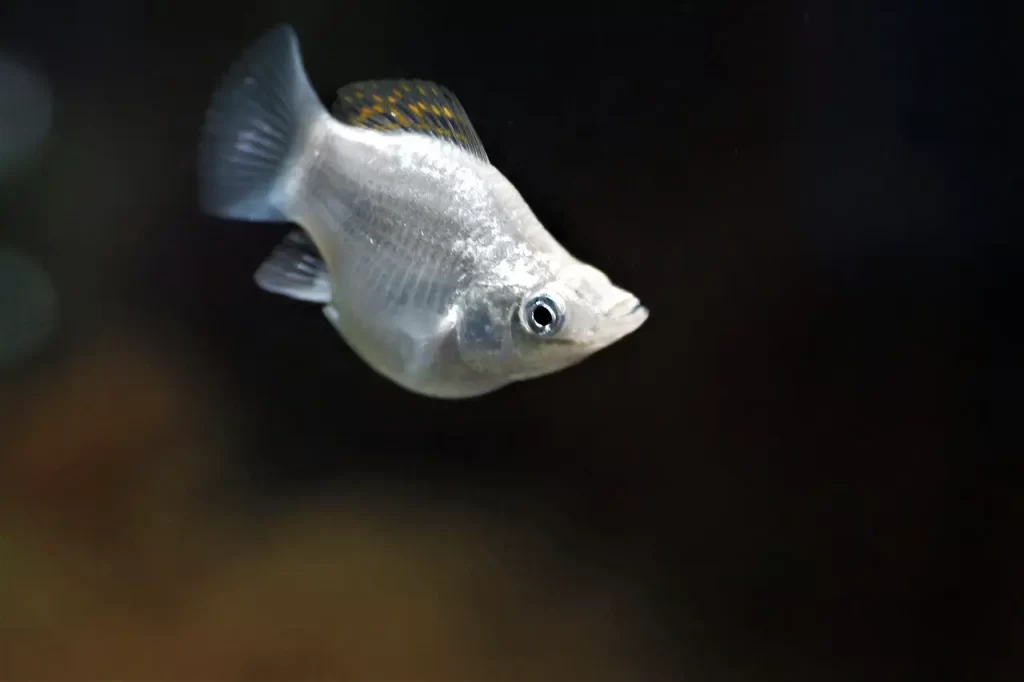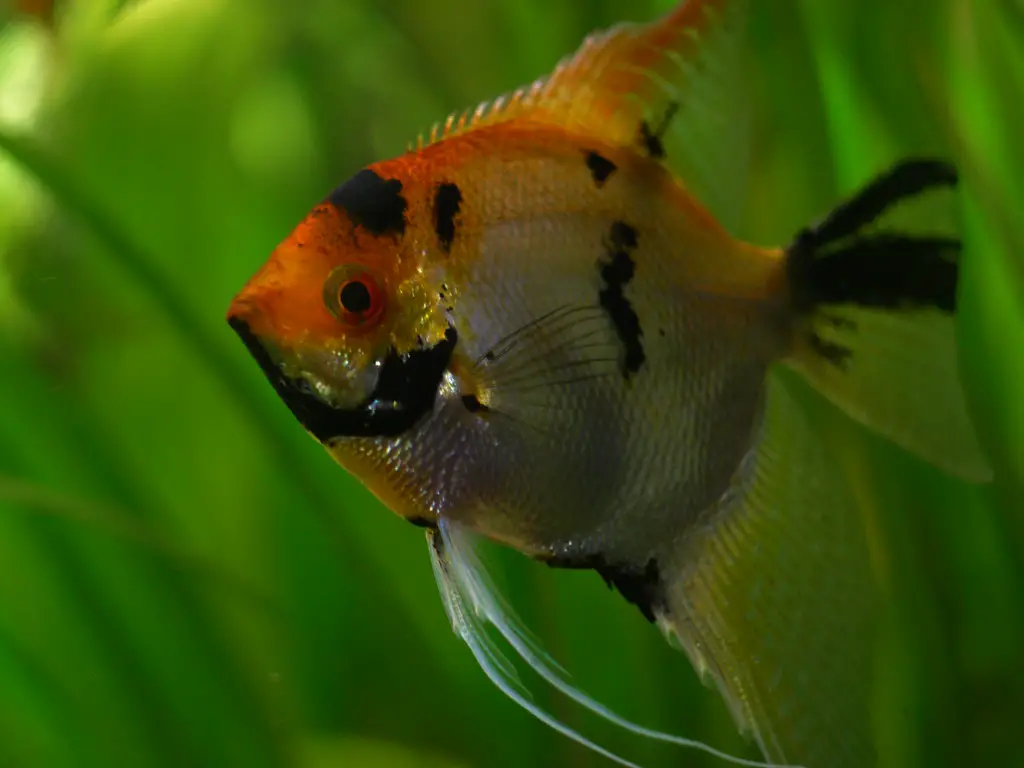Molly fish are small-sized tropical fish, generally called short-finned molly or common molly. Mollies are one of the most popular livebearers in the fish-keeping hobby. They give birth to young fry instead of laying eggs. They are found in freshwater streams, coastal brackish, and marine water of Mexico, Central America, and southern parts of South America in the wild environment. Native species of mollies are dull and silvery in color. However, the most common are three molly species, sailfin mollies and short-finned mollies. The Mexican variety is rare, difficult to breed indoors or in captivity, and challenging to care for. Nowadays, due to crossbreeding in captivity, there are a lot of different species of mollies. Mollies are hybridized with other species in the more colorful, exciting specimen. Almost all other type originates from short-finned mollies or sailfin mollies.
Molly fish are relatively hardy fish and can accept a wide range of water parameters; therefore, they are easy to care for.
This is the reason; mollies are favorite among beginner aquarists. However, to keep them happy and healthy in your aquarium, you need to provide a specific range of water parameters in the molly tank.
Mollies are somewhat similar to swordtail fish. They have a short and rectangular body upturned mouth similar to a swordtail.
Male molly grows up to 8cm, while female molly fish can grow up to 12cm. Males are more torpedo-shaped, and females are broader at the abdomen’s rear. Male molly has a pointed gonopodium and modified anal fins for breeding purposes.
Origin of Molly Fish
Mollies originated from Central America to Southern America. These fish are typically found in freshwater streams where it meets the saltwater.
However, they have quite a unique ability to live in freshwater and saltwater. As a result, you can encounter Sailfin mollies in the streams of Texas, Carolina, Virginia, and Florida.
You can find Short-finned mollies in the water of Columbia and Mexico, whereas the Yucatan molly or the Mexican variety is only found in Mexico’s Yucatan Peninsula.
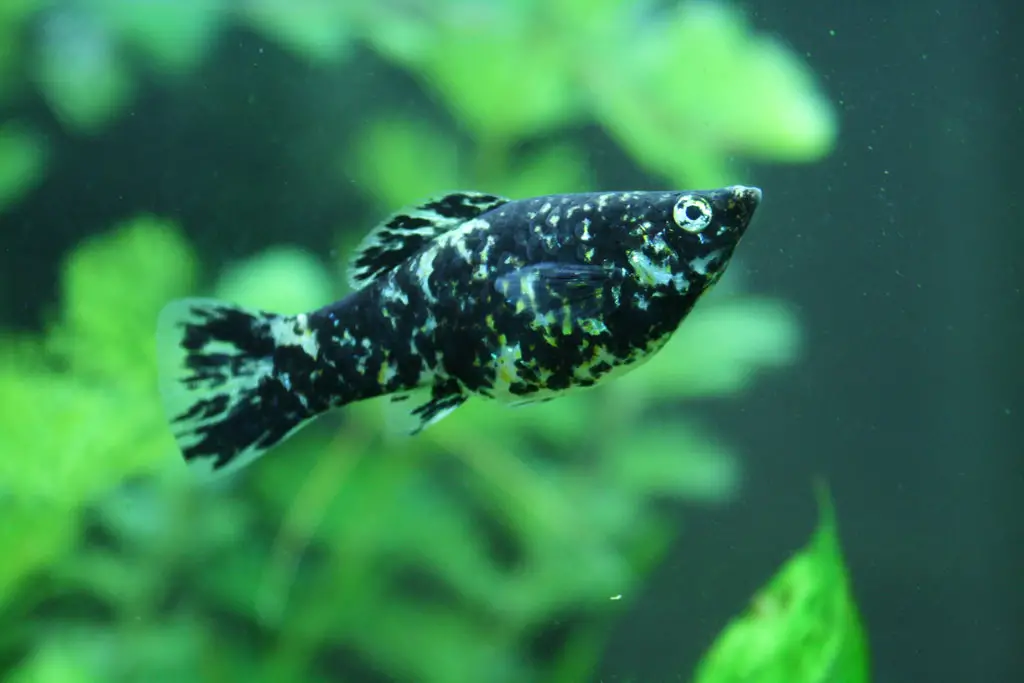
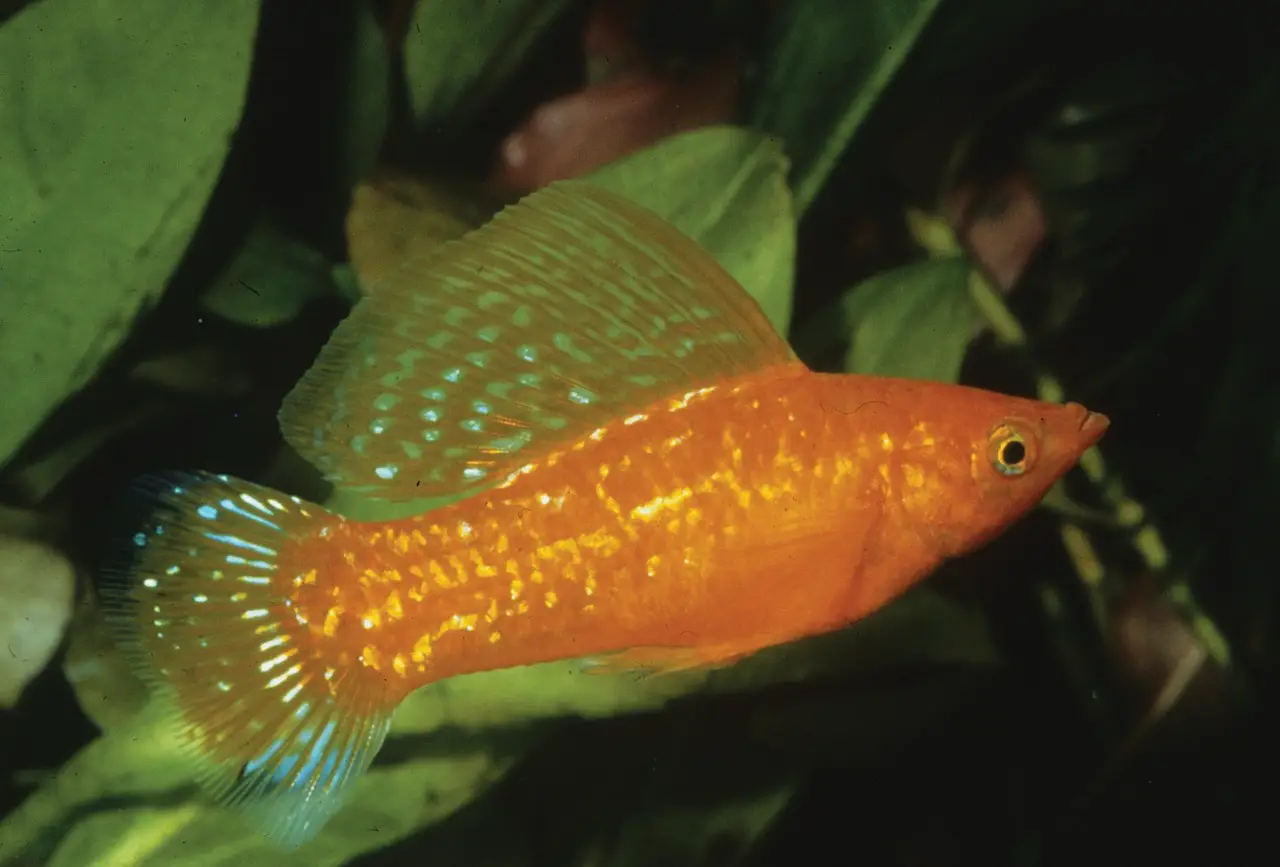
Therefore, mollies’ habitat is diversified; you can encounter them in brackish water, salt water, and freshwater with different water parameters, i.e., water temperature, pH, and hardness.
Molly Fish Description
Appearance Of Molly Fish
Molly fish are small size tropical fish. They have a short and rectangular body upturned mouth similar to a swordtail. Male molly grows up to 8cm, while female molly fish can grow up to 12cm. Males are more torpedo-shaped, and females are broader at the abdomen’s rear. The growth stages of molly fish decide how they will look and how big they will get; keep that in mind.
Personality Of Molly Fish
Mollies are peaceful and can keep them with any non-aggressive fish. Fish like platy, swordtail, guppy, glowlight tetra, neon tetra, etc., are best as molly tank mates.
Male and female molly live together in a tank without being aggressive to one another or any other fish in the community tank.
Molly fish breeds like rabbits in your tank, so if you are planning to make some money out of molly, remember that they eat their fry, so separate them.
It comes in various sizes and colors. Black Molly, balloon molly, gold dust molly, Mickey Mouse molly, black sailfin molly, etc., are some of the favorite breeds of molly.
Price Of Molly Fish
Molly fish are sold reasonably, making it an excellent fish for beginner aquarists on budget. They usually cost around $2 to $3 per pair. Molly fish are the perfect fish for you if you are a beginner with a very low budget.
Molly Fish Care
Mollies are some of the coolest aquarium fish you can buy. They don’t need a massive tank of high-end aquarium setup. Instead, let’s look at some of the most crucial aspects of keeping molly fish.
With your proper care, mollies can live up to 5 years. Mollies are rarely aggressive and usually get along with most other tropical fish.
Molly fish is the best choice for a beginner. It is a hardy fish; it can withstand different environments. However, you have to take care of various aspects including the purchase of various equipment for molly fish.
So, let’s discuss that below:
Tank Size:
Before keeping mollies in your tank, the first item to check is your tank volume. Most the fish keeper makes a mistake in choosing an aquarium.
To keep molly healthy and happy, a minimum of the 20-gallon aquarium is appropriate for a small group of mollies.
On the other hand, mollies are fast swimmers and swim around a lot. Therefore, a 30-gallon heavily planted tank would be the best one.
A larger tank is better balanced in water parameter fluctuations, so why keep them in a small tank? Let them feel at home in your tank.
And sailfin mollies grow much larger than short-finned relatives; get a much bigger tank, at least a 29-gallon aquarium, if you plan to keep sailfin mollies.
Best Aquarium For Molly Fish:
These aquariums come with the whole kit that you will require. However, you will need to buy the stand separately if you don’t have a good and sturdy base for your tank.
For 20 Gallon:
Tetra 20-gallon complete aquarium kit
Imagitarium Newport Wooden Tank Stand – for 20 Gallon Aquariums
For 29 Gallon:
Aqua Culture 29-gallon aquarium starter kit
Imagitarium Brooklyn Metal Tank Stand, 29 Gallons
Water Quality:
The next most important factor is water quality. Aquarium fish are cold-blooded animals; their body temperature depends upon the temperature of the water.
The fluctuation in water temperature in molly fish tank leads to many fish diseases like fin rot, white spot disease, velvet disease, fungal diseases, etc.
Likewise, they need a good filtration system to live a healthy life. So, let’s look at molly’s requirement to live a happy life in your aquarium.
Water Temperature
Mollies are hardy fish; these fish can adapt to quite a wide range of water temperatures. First, however, you need to provide them with a temperature that they feel safe.
The recommended water temperature for molly fish is 70 – 80 F (20 to 25 C). As a helping hand, keep an automatic electric heater and a thermometer to watch the temperature since temperature fluctuation can cause stress in fish leading to various types of diseases.
Buy quality brand heaters because they are safer, don’t explode, and reduce your electricity use. Here are the heater and Thermometer I use.
Water pH Level and Hardness:
Molly fish live in brackish water. Fish living in brackish water can tolerate a wide range of salinities and pH. pH varies for different mollies, where the ideal pH for mollies is 7.5 – 8.5.
You should change one-third of the water every week and change water steadily to keep the changing process less stressful for your mollies.
You can add aquarium salt or sea salt to your molly’s tank, ¼ cup of marine salt per gallon of water. And the ideal water hardness of the water should be between 20 to 30 dGH.
Water Filtration

Mollies are capable of thriving in various water parameters. However, you must install a filter in the molly fish tank for optimum water quality.
A filter will filter your aquarium water and help beneficial bacteria to colonize in the filter media.
This will help in the Aquarium Nitrogen Cycle. If you ask any professional and experienced aquarists, they will always recommend a filter with a higher capacity than what you need for the tank. For me, a Canister filter or a sump filter works the best.
For small aquariums, i.e., 40-70-Gallon, Fluval’s C4 Power Filter works the best. It will make your aquarium look cleaner since it’s a clip-on filter or Hang On Back Filter.
Water Maintenance
No matter what kind of filtration system you use or how clear your aquarium water is, you must maintain your aquarium water and equipment.
Have you ever wondered about living in a septic tank?
What will happen to your body if you stay your whole life in a bathroom where you poop?
Will you be healthy?
Can you imagine that situation?
No right?
Then how can a fish live in a tank that is not filtered nor maintained? Wil that poor fish be happy? This is the reason; you need to maintain your aquarium often.
As an aquarium is a closed system, all the bacteria remain in that aquarium unless you……. yes, YOU remove them and replace them with fresh water.
Without a filter, it’s a pain in the ass to do a water change daily. So get a decent-sized filter so that you don’t need to do a water change daily.
However, you need to change at least ¼ of the water every week. So, first, test the water parameter, I.e., water temperature, pH hardness, ammonia, nitrite, and nitrate.
Buying these test kits separate is as expensive as hell. But it’s like no pain, no gain. As if you want to go to a 5-star hotel and expect to pay the amount you spend in a café.
If you cannot afford to spend money on your fish, fishkeeping is not your hobby.
For those looking for these test kits, I recommend getting API FRESHWATER MASTER TEST KIT. I have been using this kit for more than a year now; it’s cheap and has all the kits I need to examine my aquarium water.
Molly Fish Diet
Molly fish are omnivores, so they eat all kinds of food in the market. Therefore, what to feed molly fish is not a difficult question; you will find various fish food on the web as an answer. The only thing I like to recommend is that it feeds your fish a variety of food.
Imagine a situation where you are eating the same food every single day. How long can you go for a week? A month? Will you be healthy?
No! Because a single food will not have all the nutrients your body needs. Likewise, fish also needs variety in the diet, you need to feed them with a fibrous meal, protein-rich food, carbs, vitamins, and you name it.
Therefore, feed them a mixed diet, and remember not to overfeed the fish; else, your water quality will degrade. Instead, feed them a pinch of food twice a day. That will be enough. Here is a list of all the fish food I give to my fish.
Molly Fish Tank Mates:

Mollies are peaceful fish suitable for a tropical freshwater community aquarium with small fish. However, they are also known to nip the fins of other fish at breeding occasionally. But these mollies are not fin nippers in general; they behave drastically when things go south in the tank.
Some aquarists prefer keeping mollies in a single species aquarium when these fish are breeding. If you plan to keep them in a community tank, keep an eye on them as they sometimes nip fish fin.
But do not keep molly fish alone in the tank, these fish are shy but social, so it is quite depressing for them. Also, mollies are aggressive when they are kept alone without females, so add a female to your tank to keep their attention n peace in your aquarium.
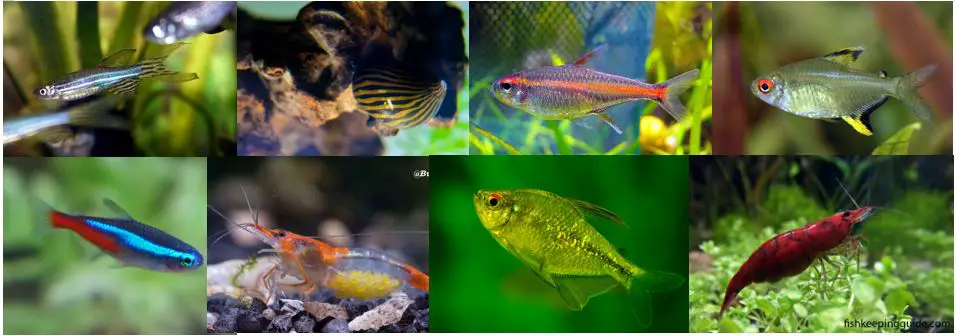
The best tank mates for mollies are other species of livebearer fish like a guppy, swordtail, platy, and other mollies. Some of the other species like Danios, glowlight tetra, neon tetra, snails, red cherry shrimps, and Amano shrimp will do well.
How Many Molly Fish Can My Aquarium Hold?
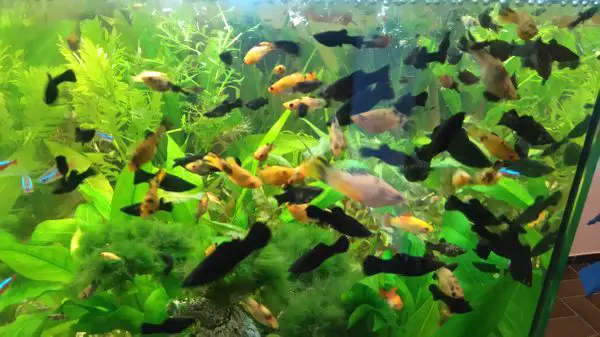
When you are keeping any fish, the first thing you need to consider is the adult size of that particular fish.
One inch of the size of fish requires one gallon of water. Therefore, in the case of molly fish, they can grow up to 4 inches.
So, keep four to six mollies in a 20-gallon aquarium to keep them happy as it is an ideal aquarium size for the molly fish group.
And a ratio of two females for each male molly fish is always recommended because mollies are hyperactive and will always be chasing female mollies.
So do not keep two male mollies in the tank if there are not enough females to balance the ratio. This will also help you to control breeding.
If you plan to create a great scape in your aquarium with plants, rocks, and driftwood, go for at least a 75-Gallon aquarium, this will be large enough for a group of molly fish.
In addition, larger tanks help you maintain the aquarium’s water parameter as the population of mollies increases.
Lighting the Molly Tank
Mollies do not have a specific need for lighting their aquarium. However, if you are planning to keep live plants in a molly fish aquarium, you need to provide proper lighting to promote the growth of the plants. Therefore, mollies might not need great lighting, but their tank might.
Fluorescent Light Vs. LED Lights
A low-watt fluorescent light will do fine if you keep mollies by themselves. A fluorescent light will make your tank look good, but it will also save you money.
If you plan to keep live plants, buy a special fluorescent bulb designed to promote plant growth. But I recommend you buy LED lights because the fluorescent light needs to be changed every six months as they fade away and their spectrum shifts as they age.
So get a LED light; they last longer than any lights and consume far less power than any other lights. Some of them even come with a timer so that you don’t have to switch them on and off manually every single day.
How Many Lightings Do Molly Fish Require?
Aquarium lighting is essential for the proper development of mollies. Lightening helps to mimic your mollies’ natural environment in your aquarium; it helps to regulate your mollies’ eating and sleeping.
In addition, plants require light for photosynthesis. So for an aquarium with only your molly fish, you just need the amount of light to see your molly fish.
Since low light won’t promote algae growth in your aquarium, you can light your tank for several hours. However, if you are keeping plants in your molly’s aquarium, one to five watts per gallon of water works the best depending on what plants you are keeping.
On average, you need to light your aquarium for 8-10 hours a day. It is essential for fish or plants to have scheduled lighting, i.e., day and night, as our aquarium needs to replicate the natural habitat as much as possible.
If your light does not have a timer inbuilt, you can purchase it separately. This timer costs a couple of dollars and helps so much.
Breeding Molly Fish
Like most other livebearer fish, molly fish are extremely prolific breeders. Unfortunately, they breed like rabbits are quickly overpopulate your aquarium.
Molly fish are known for eating their fry, so it is important to add a lot of plants and hiding places for the fry. I prefer adding a lot of java moss, anubias, and java fern in my breeding tank.
If you don’t want to set up a planted tank, the other option you can choose is to separate the fry from their parents. You can start breeding mollies when you are done setting up the tank and molly attains the age of 3 to 5 months.
You can separate pregnant molly fish into a breeding tank and again transfer the female molly fish to the display tank.
Fry is free-swimming at birth and accepts any food flakes or algae. Therefore, provide them with quality fry food to develop.
Setting up Molly Breeding Tank
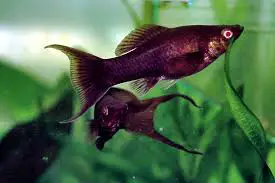
I have been breeding mollies besides breeding guppies, swordtail, and platy.
Setting up a breeding tank is similar to all the livebearers. However, the main advantage of setting up a breeding tank is that you have all the control of breeding.
When I started breeding mollies, I had four mollies; three females and a male. After a couple of months, I had so many in my tank that I had to sell them to a pet store. And after a couple of months further, I was breeding them for money.
Let’s look at the steps to set up the breeding tank.
Get a Decent Sized Tank
A 20-Gallon aquarium is a suitably sized aquarium. But as you grow the population, you need a bigger aquarium for me; I would purchase at least four aquariums a 20-Gallon, two 75 Gallon, and a 50-gallon.
- The two 75-Gallon aquaria are for separating the male and female mollies once they reach their maturity.
- The 20-Gallon tank is for breeding the mollies; I select the best color out of hundreds of my molly and keep them in the breeding tank where they do their job.
- A 50-Gallon aquarium to transfer the fry from 20-Gallon since breeding pairs always occupy the breeding tank.
Decorate Your Breeding Tank
Here to decorate the tank, I mean to add plants and driftwoods and rocks so that the fry has enough hiding place. Let the tank cycle for several weeks before adding your breeding pair.
Stock Your Tank
The final stage is to add your breeding pair to the tank and let them do their work. Introduce three females to one male.
How Do You Know If Your Molly Fish Is Pregnant?
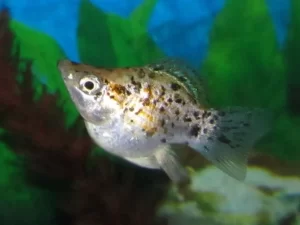
Now that you have set up the breeding tank for molly, let them do their work, and your job is to wait and watch.
After several days you will notice some changes in female molly fish. These changes are the sign that your molly fish is pregnant, not fat. The following are the signs that your molly fish is pregnant and is about to give birth.
- A bright-colored molly will get its color changed to a darker shade.
- Another sign in the bright-colored female is the appearance of the black line on the lower belly.
- The female molly’s abdomen starts to get bigger and swollen.
- The dark spot at the back of the abdomen is literally the eyes of all the babies.
After you notice these signs, separate the pregnant molly fish and mark your calendar as they will give birth to their fry in 60 days. Once they are ready to give birth, they will give birth to 40-100 fry.
Molly Fish Pregnancy Stages or Cycle
Molly fish are very easy to breed, and most of the time, mollies are already pregnant when purchased at a pet store. There are four stages in the molly fish pregnancy cycle: fertilization, gestation period, fry, and adult.
Fertilization
Mollies are livebearers; they give live birth to laying eggs. So, the fertilization process happens inside a female’s body. A male molly will inseminate the eggs while they are inside the female.
This is why you see a male molly chasing female mollies every single time. The female mollies carry her eggs inside her belly until the fry is fully developed and ready to release.
Gestation Period
The next stage is the Gestation Period; the gestation period of a molly fish is around 60 days. Therefore, once molly fish is pregnant, they will be giving birth to the fry after 60 days.
This is when you notice changes in the female body, i.e., signs that she is pregnant. One of the exciting facts about mollies is that a female molly can store sperm for months.
She can even use it to fertilize the eggs without the presence of a male. I also tried this and found out that it was true.
She can get pregnant even if there is no male in the tank. So I guess I have answered your question on How Long Do Molly Fish Stay Pregnant.
Molly Fish Fry
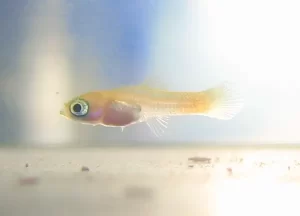 In the next stage, after completion of the gestation period, female mollies give birth to cute little molly fry that looks like a small tadpole with a transparent body.
In the next stage, after completion of the gestation period, female mollies give birth to cute little molly fry that looks like a small tadpole with a transparent body.
It’s sad that the young ones, even the mother, hunt the fry and eat them.
Therefore, to eliminate this situation, place the female in a breeding net or a tank to separate the fry from larger fish that might eat them.
Once the female gives birth, separate the molly fry and mother immediately; transfer the female molly fish to the display tank and separate the fry to the fry tank.
Adult Molly
Feed your fry quality food, and they will grow up healthy in no time. It takes around one to two months for the molly fish fry to grow large enough to transfer them to the display tank with other fish.
For a fry to reach adulthood, it will take around 4-6 months, depending on the food and water parameters you maintain.
A female molly fish can produce over 10 to 60 fry in one birth. But these mollies will not give birth all at once, so you have to wait for a while for the delivery process to end.
The breeding cycle of molly fish lasts around 40 to 60 days. And it is not hard to distinguish if your molly is pregnant o fat; notice an increase in belly size and spot when a female is pregnant.
Place the female molly in the nursery tank as the male chases around and stresses outs the female. You can also use an aquarium net breeder.
Stress mollies may have more aborted births and stillborns before the birth date. Mother Molly will eat her own young, moving her back to other fish.
One male for four females is the best combination. More females aid lessen stress by spreading the pressure among several females.
You should heavily plant the molly aquarium providing female mollies and fry with lots of hiding space. Mollies and other tank mates will eat fries, considering them as food. If you want a specific color or new varieties, get selective breeding.
Caring Molly Fry
Molly fry doesn’t get protection from their parents. Therefore, these tiny little fry needs your help to survive.
First, you need to separate the fry from adult fish or their parents. I would recommend you buy a separate tank for the fry to grow. But you can also use a breeding box to separate the fry in the tank.
Feeding Molly’s Fry
I like to feed you molly fry egg yolks and brine shrimp. I just hard-boil the eggs and give the egg yolks a little at a time.
Make sure you remove excess and uneaten egg yolks from the tank; else, the water might get contaminated, killing all your fry.
Once they are a bit bigger, prepare brine shrimp; preparing brine shrimp is very easy; you just need an air pump, a bottle, a light source, and water.
Add brine shrimp eggs to the bottle and provide aeration from an air stone, give adequate lighting, and your brine shrimp will hatch the next day.
You can even feed them food pellets and flakes, crushing them into a fine powder. Like the adult mollies, their fry is also easy to care for and will accept anything you give them. Make sure that you give them very little food at a time twice a day.
Filtration and Temperature for Molly’s Fry
 A sponge filter is the best filter for your molly fry’s aquarium. However, a power filter can suck the fry as they are not strong enough to deal with the water current.
A sponge filter is the best filter for your molly fry’s aquarium. However, a power filter can suck the fry as they are not strong enough to deal with the water current.
A sponge filter is an excellent filter for housing beneficial bacteria that will help the Aquarium Nitrogen Cycle process.
Look after tank temperature in the tank; molly fry requires a tropical temperature between 72 to 84 degrees Fahrenheit.
Equip your molly aquarium with a high-quality aquarium heater. Change the water regularly to make sure your fry is healthy.
It will take 1 to 2 months for your fry to grow larger enough to be introduced into the main tank. Fry should be larger than the mouth of an adult molly fish.
So keep an eye on their growth. After an introduction to the tank, watch juveniles for a couple of days to ensure their health and safety.
Common Molly Fish Diseases
Something doesn’t look right, and take a closer look at your aquarium, your molly is sick, and there are common external signs of illness. But, technically, it is not a disease but a syndrome due to poor water conditions.
Signs Of Diseases In Molly Fish
If your molly is swimming alone from the group, it can be an early sign of disease. In aquarium fish, rubbing up against objects may indicate irritated skin caused by external parasites.
Crowding near the filter and gasping for air at the surface is gill disease or gill damage by parasites, bacteria, or viruses.
Disease-Causing Pathogens
The three pathogens cause bacterial infections: Aeromonas, Vibrio, and Pseudomonas. But unfortunately, it isn’t easy to decide which pathogen is responsible.
They have similar symptoms like cloudy eyes, bloody patches, decaying or frayed fins, and scratching. Sometimes loss of appetite and swollen abdomen can also be a bacterial infection. If bacteria infect your fish, you need to treat the entire aquarium.
Velvet Disease
The protozoan Piscinoodium causes velvet disease. Velvet is parasitic algae containing chlorophyll. An expert often suggests darkening your tank if your molly shows a velvet outbreak.
Chlorophyll requires light to survive. If your molly suffers from velvet, you will notice clamped fins and small yellow spots. If gills are affected, your molly will be gasping for air.
Velvet has two life stages: a cyst form and a free-swimming form. Starting stage, i.e., infected, is the free-swimming stage.
The velvet parasites drive themselves through the water until it finds a suitable host during this stage. Then attach to gills or skin of the molly and form cyst working on releasing 100 of free-swimming piscinoodinium.
Finally, the release of piscinoodinium searches for another host, and the cycle begins again. Therefore, velvet is very contagious.
Treatment
Copper sulfate seems to be the best treatment. However, be extra careful; overdose with copper sulfate can easily kill or poison your mollies. You should change the water slowly after treatment is complete. But only the free-swimming stage is affected by copper sulfate, not the cyst.
Prevention is Better than Cure
As we know, prevention is better than cure; therefore, taking preventive measures is essential.
- Take the best tank size aquarium with heavily planted to avoid stress to your mollies.
- Always avoid a sudden change in the water parameter.
- Quarantine your new mollies for 40 days, which prevents the spreading of most parasites into the tank.
- Purchase your mollies from reliable sources.
- Always feed your mollies, and it’s fry quality food available commercially.
- Avoid overfeeding and overcrowding.
- Do not share equipment like nets between aquariums. Instead, soak in water above 90 degrees Fahrenheit for about 10 minutes if you have to.

